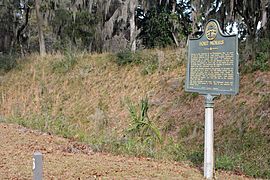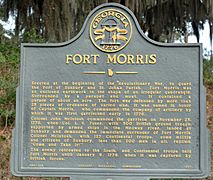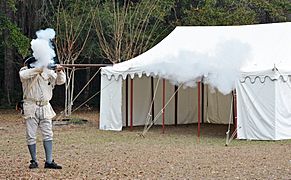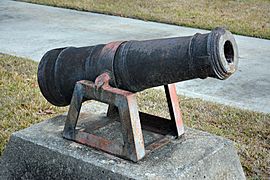Fort Morris facts for kids
Quick facts for kids |
|
|
Fort Morris
|
|

Earthworks in the distance
|
|
| Location | Near Midway, Georgia |
|---|---|
| Nearest city | Midway, Georgia |
| Area | 7 acres (2.8 ha) |
| NRHP reference No. | 70000208 |
| Added to NRHP | May 13, 1970 |
Fort Morris is an old fort made of earth in Liberty County, Georgia. It sits right on a curve of the Medway River. This fort was super important for protecting the southeastern part of Georgia for many years.
It was used in several big wars, starting in 1741 and ending in 1865. These wars included the French and Indian War, the American Revolutionary War, and the War of 1812. The whole historic area is about 70 acres, which is like 50 football fields! It's also about 23 feet above sea level.
On May 13, 1970, Fort Morris was added to the National Register of Historic Places. This means it's a special place recognized for its history. Today, you can visit it as a state park called Fort Morris Historic Site.
Contents
Fort Morris: A Look at Its History
Fort Morris has a long and exciting history, playing a part in many important events that shaped America.
Early Days: French and Indian War
The very first fort here was built in 1741. It was meant to protect a large farm, called a plantation, owned by Captain Mark Carr. He had 500 acres of land given to him by the Georgia Trustees. Captain Carr was a leader in the British Colonial Army.
- In 1741, his farm was attacked by Native American groups who were friends with the Spanish in Florida.
- Several soldiers defending the fort were killed.
- The attackers took everything from the fort and farm using a large boat.
Another fort was built in 1756 because local people were being attacked by Creek Indian groups during the French and Indian War. This fort was made bigger in 1758 to protect a new town called Sunbury.
- The fort was square, with each side being 100 yards long.
- It had eight cannons to defend it.
- By 1762, the fort was not in good shape and needed repairs.
Fighting for Freedom: The American Revolution
When the American Revolutionary War began, Georgia needed to defend the Medway River and Sunbury again. The American government decided to build two forts in Georgia. One was in Savannah, and the other was at Sunbury.
- A group of 50 soldiers with cannons was sent to the area.
- Fort Morris was built southeast of Sunbury.
- It was used as a base for trying to take British Florida.
- Later, it became a key defense point for Sunbury and other places up the river.
The American forces could not take control of Florida. Florida had become a safe place for people who stayed loyal to Britain. The British Governor of East Florida wanted to invade Georgia.
- British soldiers, loyalists (Americans who supported Britain), and Native American allies planned to take Georgia.
- In 1778, they quickly captured Savannah.
- Next, they moved towards Sunbury and Fort Morris.
Colonel McIntosh's Brave Stand
On November 25, 1778, a small group of British soldiers tried to take Fort Morris. About 200 American soldiers, led by Colonel John McIntosh, were inside. When the British demanded they surrender, Colonel McIntosh famously replied, "Come and take it!"
- The British decided not to attack that day and left.
- They came back in January 1779 with a much larger force.
Fort Morris Falls
The British attacked Fort Morris on January 9, 1779. The fort was captured the next day. Not many lives were lost in this battle, likely fewer than twelve American soldiers and even fewer British soldiers.
- The British renamed the fort Fort George.
- They held it until September 1779.
- Then, they moved their soldiers to Savannah to help defend it.
After the British left, American forces took the empty fort back. They found only a few broken cannons. They held the fort for only a month before the British took it again in October. Fort Morris, or Fort George as the British called it, stayed under British control until 1782.
Another Conflict: The War of 1812
After the Revolution, the fort again fell apart. But the need to protect Sunbury and the river came back during the War of 1812.
- A new fort, called Fort Defiance, began construction in 1814.
- It was built on the same spot as Fort Morris.
- However, the war ended before the fort was finished, so it was left incomplete.
The American Civil War: A Small Role
Fort Morris and Sunbury played a small part in the American Civil War.
- A small group of Confederate soldiers were stationed in Sunbury.
- They might have used the fort.
- In 1864, during General William T. Sherman's March to the Sea, Union soldiers came to the area.
- They removed some cannons from the fort and took them to Union-controlled forts on the Atlantic coast.
Images for kids
See also








